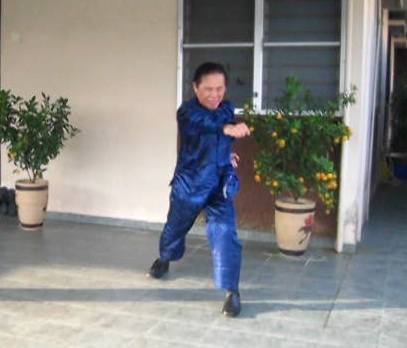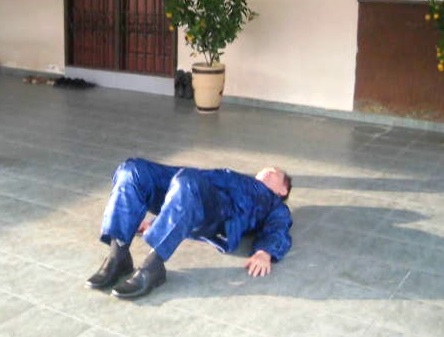STORY OF LOHAN FIST AND ITS ADVANTAGES COMPARED TO OTHER MARTIAL ARTS

The early version of the Lohan Fist is simple, consisting mainly of straight-forward punches and kicks
Question
Can you tell us the story of the evolution of the 18 Lohan Fist?
What are its advantages compared to other martial arts?
Sifu Andy
Answer
The Eighteen-Lohan Fist was evolved from the Eighteen Lohan Hands.
When Bodhidharma taught Zen meditation at the Shaolin Temple in the 6th century, he found the monks weak. So he taught the Eighteen Lohan Hands to strengthen them physically, emotionally, mentally and spiritually so as to better attain Enlightenment.
Shaolin Temple was an imperial temple. There were also many retired generals as monks at the Shaolin Temple. These retired generals, who were different from the other weak monks, modified the exercises in the Eighteen Lohan Hands for their personal needs.
This modification was not a concerted effort by the martial monks collectively. The modification was carried out on a personal, spontaneous basis. Over time these modified patterns were quite different from the original patterns of the Eighteen Lohan Hands, and were practiced not just as chi kung exercises for health, but as kungfu techniques for combat.
These kungfu techniques were collectively called Eighteen-Lohan Fist, or Shi Ba Luo Han Quan in Chinese, in contrast to Eighteen Lohan Hands, or Shi Ba Luo Han Shou. Initially there were 18 patterns in the Eighteen Lohan Fist, with each pattern of the chi kung set modified into a pattern in the kungfu set. However, because of the different periods these modifications were made, there were different versions of the Eighteen-Lohan Fist.
More patterns and more modifications were added to the Eighteen-Lohan Fist. By the time of the Tang Dynasty in the 19th century, there were sets with 108 patterns. Eighteen-Lohan Fist became the prototype of Shaolin Kungfu.
Over its long history, many kungfu styles developed from Shaolin Kungfu, like Taizuquan, Wuzuquan, Taijiquan, Xingyiquan, Eagle Claw and Praying Mantis from the northern Shaolin Temple, and Hoong Ka, Wing Choon, Choy-Li-Fatt, White Crane and Dragon Style from the two southern Shaolin Temples.
Lohan Kungfu also developed into a style of its own. This Lohan Kungfu style had many unarmed and weapon sets. There were ten unarmed sets, and they were conveniently named First Lohan Set, Second Lohan Set, etc. The weapon sets were just named after its type of weapons, like Staff Set, Sabre Set, Spear Set and Big Knife Set.
Although Lohan Kungfu, especially its earlier versions, is relatively simple compared to later kungfu styles that developed from it, like Chaquan, Eagle Claw, Praying Mantis, Hoong Ka and Choy-Li-Fatt, it is more sophisticated than non-kungfu martial arts, like Karate, Taekwondo and Muay Thai. It is also comprehensive, i.e. it has all the four categories of attack and defence, whereas the combat techniques of non-kungfu martial arts are rather restrictive. For example, Karate is mainly restricted to strikes, Taekwondo to kicks, and there are no felling and gripping attacks in Muay Thai.
Herein lie its advantages. Its simplicity yet comprehensiveness compared to more sophisticated styles like Eagle Claw and Hoong Ka, makes it easier to learn and be applied for combat. If all other factors were equal, students would be better trained in both solo performance and fighting in Lohan Kungfu than in Eagle Claw or Hoong Ka. Typical Lohan patterns are easier to perform, and their combat application is obvious, but the elaborated patterns of Eagle Claw and Hoong Ka may not.
On the other hand, the simplicity yet comprehensiveness of Lohan Kungfu is a great advantage over non-kungfu martial arts, like Karate, Taekwondo, Boxing, Kick-Boxing and Muay Thai. Although Lohan Kungfu is simple, there is still more variety in Lohan Kungfu than the other martial arts. The strikes in Karate, for example, are mainly forward punches, but there are many different ways of striking in Lohan Kungfu. The kicks in Taekwondo leave its exponents exposed, but kicks in Lohan Kungfu are well covered.
Lohan Kungfu is sufficient to handle any form of attack, but the other martial arts are inadequate if opponents use techniques outside the repertoire of these arts. If you grip a Karateka, fell a Taekwondo exponent, or kick at a Boxer, for example, they would have no techniques in their repertoire to counter.
The early versions of Eighteen-Lohan Fist were simple. In fact, about 30 years ago in the 1980s when I first bought a book on the Eighteen-Lohan Fist, which I later learned was of an early version, I was surprised to find that its patterns were mainly straight-forward punches and kicks! Lohan Kungfu developed too, and in its long history it has incorporated sophisticated techniques from other styles.
While maintaining its original flavor, our Shaolin Wahnam version of Eighteen-Lohan Fist contains many sophisticated techniques. Many other martial artists as well as kungfu practitioners of other schools may think some of these patterns merely decorative, when in fact they are very effective for combat.

The later version, like our Shaolin Wahnam version, of the Lohan Fist consists of sophisticated patterns that many martial artists may not know their combat application. Do you know, for example, the combat application of this pattern, "Immortal Stretches Waist"?
Little Lohan Fist
18-Lohan Fist
Treasure House of Kungfu Sets
Treasure House of Combat Application
Those who wish to attend the 18-Lohan Fist course in Frankfurt, Germany on 26th, 29th, 30th September and 1st October 2014, please contact Secretary, Wahnam Germany or phone (069) 904-31954.
The questions and answers are reproduced from the thread 10 Questions on 18-Lohan Fist in the Shaolin Wahnam Discussion Forum.
LINKS
